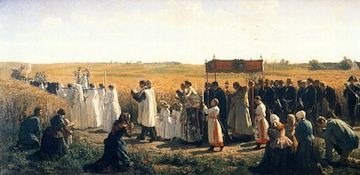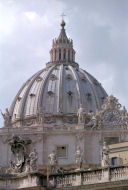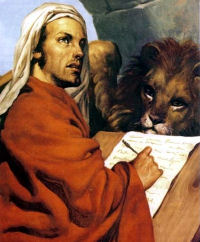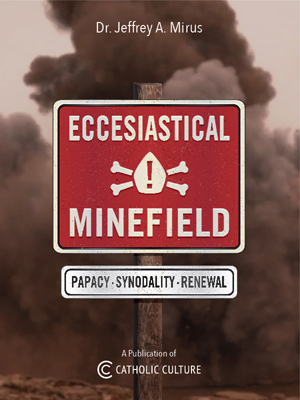Easter: April 25th
Feast of St. Mark, evangelist
Other Titles: The Greater Litanies; Major Rogation Day
» Enjoy our Liturgical Seasons series of e-books!
St. Mark, the author of the second Gospel, was the son of Mary whose house at Jerusalem was the meeting place of Christians. He was baptized and instructed by St. Peter. In about the year 42 A.D. he came to Rome with the Prince of the Apostles. There at the request of the faithful he wrote his Gospel about the year 50 A.D. His Gospel is a record of St. Peter's preaching about Our Lord and pays special attention to the head of the Apostles. The Gospel was written for Roman Gentile converts. It rarely quotes the Old Testament, and is careful to explain Jewish customs, rites and words. It excels in portraying the emotions and affections of both Christ and His hearers. St. Mark preached in Egypt, especially in Alexandria and was martyred there by the heathen.
According to the 1962 Missal of St. John XXIII the Extraordinary Form of the Roman Rite, today is the Feast of St. Mark, and the Major Rogation. While no longer required after Vatican II, Rogation Days can still be observed by the faithful. Fasting and penance were required, and the faithful would especially pray Litanies on this day.
What are Rogation Days?
"Rogation Days are the four days set apart to bless the fields, and invoke God's mercy on all of creation. The 4 days are April 25, which is called the Major Rogation (and is only coincidentally the same day as the Feast of St. Mark); and the three days preceding Ascension Thursday, which are called the Minor Rogations. Traditionally, on these days, the congregation marches the boundaries of the parish, blessing every tree and stone, while chanting or reciting a Litany of Mercy, usually a Litany of the Saints".
St. Mark
John Mark, later known simply as Mark, was a Jew by birth. He was the son of that Mary who was proprietress of the Cenacle or "upper room" which served as the meeting place for the first Christians in Jerusalem (Acts 12:12). He was still a youth at the time of the Savior's death. In his description of the young man who was present when Jesus was seized and who fled from the rabble leaving behind his "linen cloth," the second Evangelist might possibly have stamped the mark of his own identity.
During the years that followed, the rapidly maturing youth witnessed the growth of the infant Church in his mother's Upper Room and became acquainted with its traditions. This knowledge he put to excellent use when compiling his Gospel. Later, we find Mark acting as a companion to his cousin Barnabas and Saul on their return journey to Antioch and on their first missionary journey. But Mark was too immature for the hardships of this type of work and therefore left them at Perge in Pamphylia to return home.
As the two apostles were preparing for their second missionary journey, Barnabas wanted to take his cousin with him. Paul, however, objected. Thereupon the two cousins undertook a missionary journey to Cyprus. Time healed the strained relations between Paul and Mark, and during the former's first Roman captivity (61-63), Mark rendered Paul valuable service (Col. 4:10; Philem. 24), and the Apostle learned to appreciate him. When in chains the second time Paul requested Mark's presence (2 Tim. 4:11).
 An intimate friendship existed between Mark and Peter; he played the role of Peter's companion, disciple, and interpreter. According to the common patristic opinion, Mark was present at Peter's preaching in Rome and wrote his Gospel under the influence of the prince of the apostles. This explains why incidents which involve Peter are described with telling detail (e.g., the great day at Capharnaum, 1:14f)). Little is known of Mark's later life. It is certain that he died a martyr's death as bishop of Alexandria in Egypt. His relics were transferred from Alexandria to Venice, where a worthy tomb was erected in St. Mark's Cathedral.
An intimate friendship existed between Mark and Peter; he played the role of Peter's companion, disciple, and interpreter. According to the common patristic opinion, Mark was present at Peter's preaching in Rome and wrote his Gospel under the influence of the prince of the apostles. This explains why incidents which involve Peter are described with telling detail (e.g., the great day at Capharnaum, 1:14f)). Little is known of Mark's later life. It is certain that he died a martyr's death as bishop of Alexandria in Egypt. His relics were transferred from Alexandria to Venice, where a worthy tomb was erected in St. Mark's Cathedral.
The Gospel of St. Mark, the shortest of the four, is, above all, a Roman Gospel. It originated in Rome and is addressed to Roman, or shall we say, to Western Christianity. Another high merit is its chronological presentation of the life of Christ. For we should be deeply interested in the historical sequence of the events in our blessed Savior's life.
Furthermore, Mark was a skilled painter of word pictures. With one stroke he frequently enhances a familiar scene, shedding upon it new light. His Gospel is the "Gospel of Peter," for he wrote it under the direction and with the aid of the prince of the apostles. "The Evangelist Mark is represented as a lion because he begins his Gospel in the wilderness, `The voice of one crying in the desert: Make ready the way of the Lord,' or because he presents the Lord as the unconquered King."
—Excerpted from The Church's Year of Grace, Pius Parsch
Patronage: Against impenitence; attorneys; barristers; captives; Egypt; glaziers; imprisoned people; insect bites; lions; notaries; prisoners; scrofulous diseases; stained glass workers; struma; Diocese of Venice, Florida; Venice, Italy.
Symbols and Representation: Winged lion; fig tree; pen; book and scroll; club; barren fig tree; scroll with words Pax Tibi; winged and nimbed lion; lion.
Often Pictured as: Man writing or holding his gospel; man with a halter around his neck; lion in the desert; man with a book or scroll accompanied by a winged lion; holding a palm and book; holding a book with pax tibi Marce written on it; bishop on a throne decorated with lions; helping Venetian sailors; rescuing Christian slaves from Saracens.
Highlights and Things to Do:
- Read further about St. Mark:
- Visit online the Basilica di San Marco located in Venice, Italy. Read How the remains of Saint Mark came to be in Venice.
- Read more at EWTN and at My Catholic Life
- See Catholic Cuisine for food ideas for St. Mark. I also enjoyed San Marco Pasta from Cooking with the Saints by Ernst Schuegraf.
The Major Rogation Day
 The Roman calendar contains four Rogation days: one on April 25 (St. Mark’s day), and three before the feast of the Ascension (in Latin, Litaniae majores et minores). On these days the Church petitions intensively that God in His mercy will grant all temporal and spiritual needs, particularly a good harvest.
The Roman calendar contains four Rogation days: one on April 25 (St. Mark’s day), and three before the feast of the Ascension (in Latin, Litaniae majores et minores). On these days the Church petitions intensively that God in His mercy will grant all temporal and spiritual needs, particularly a good harvest.
In the ancient Church Rogation days were quite common; some recurred annually, others were introduced at times of particular need, e.g., averting war or pestilence. Today’s Rogation observance dates to the time of Gregory I (about 600). This Pope affixed a Rogation procession to April 25, on which day, according to ancient Roman tradition, St. Peter came to the Holy City for the first time. He also made St. Peter’s the day’s station church. April 25 was chosen to offset pagan Rome’s Robigalia, a celebration with processions in honor of the harvest god. There was no connection with the feast of St. Mark, which was subsequently assigned to this date. That is why the Rogation procession is invariably held on this day, even though the feast of St. Mark is transferred.
The liturgical celebration of Rogation day consists in a procession followed by the Rogation Mass. In this procession we have a last remnant of the old stational observance held almost daily during Lent and Easter week. The Christians of Rome assembled at a specified church (ecclesia collecta, hence the word “Collect”), and from there marched in procession with bishop and clergy to the station church where Mass was celebrated. On the way the Litany of the Saints and the Kyrie, eleison were chanted.
The four Rogation days have preserved the main elements of this venerable rite, an observance that we should respect and foster. For we should pray both perseveringly and in common, since special efficacy and power is attached to such prayer. During the Rogation procession the Litany of Saints is sung; we call upon the entire Church triumphant to intercede in our behalf. And the Litany’s concluding prayers are unusually beautiful.
—The Church’s Year of Grace, Pius Parsch
The Rogation Days
These are the Church's special days of prayer during which the faithful beseech God for mercy in behalf of the bodily and spiritual needs of humanity, and especially to obtain His blessings upon the new growth in the fields. The term Rogation has been given these days because of the supplicatory and penitential exercises which characterize them. Outstanding are the special prayers (given in the Ritual and Breviary), the violet color of the vestments of the clergy and of the vestures, the Litany of the Saints sung during the procession and the special Rogation Mass.
Formerly such observances were more numerous than today, and they included fasting and abstinence. They were held in time of public calamity to appease the just wrath of God because of sin or to beseech Him to avert impending calamities. It is still common in many places for clergy and people to proceed to the fields, imploring God's blessing upon them. Antedating the Christian observance, and which the latter replaced, was the pagan festival of the Robigalia which sacrifices were offered to the god Robigus whose special task it was, as popularly believed, to keep blight from grain.
Today the Church has four such days to be observed during the year. The one replacing the pagan festival of April 25 coincides with the feast of St. Mark, celebrated on this day, and is called the Greater Litanies. The procession is held, and the Mass of Rogation is offered up. If the procession cannot possibly be held, whether out of doors or within the church, the Mass is of the feast of St. Mark, unless it occurs on a still greater feast, or during Easter week, when it is transferred. The three other Rogation Days, also called the Lesser Litanies immediately priced the feast of the Ascension. Their observance has come down to use form the institution at Vienna in France by Bishop Mamertus in the fifth century. Pope St. Leo III, towards the end of the eighth century, introduced practice for the universal church.
—Excerpted from "The Mind of the Church after Easter and at Whitsuntide: Participation Outlines" by Rembert Bularzik, OSB, Orate Fratres 1935-05-18: Vol 9 Iss 7, pp. 292-293
Highlights and Things to Do:
- See the Rogation Days collection on Catholic Culture with further reading, prayers and recipes.
- Read more about the Rogation Days at Catholic Saints Info.
 Major Rogation Day (April 25, Feast of St. Mark)
Major Rogation Day (April 25, Feast of St. Mark)Station with San Pietro in Vaticano (St. Peter's in the Vatican):
In the fifth, possibly in the fourth century, April 25, independently of the Feast of St. Mark, was already a sacred day at Rome. Moretti tells us that it was a feast in honor of St. Peter, in memory of his arrival at Rome. The title of Greater Litanies is in contradistinction to the Rogation Procession and the Lesser Litanies. They probably date from a period before the time of St. Gregory. In ancient days, the Procession used to leave the Church of St. Mark, to go to Ponte Molle (Pons Milvius), and thence, by Monte Mario, to St. Peter’s in the Vatican.
—The Year’s Liturgy, Volume 2 by Fernand Cabrol, OSB
For more on San Pietro in Vaticano, see:
For further information on the Station Churches, see The Stational Church.






